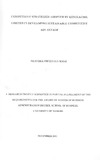| dc.description.abstract | Companies pursue competitive strategies to gain competitive advantage that allows them to outperform their rivals and achieve increased profitability. Competitive strategy, if well developed and implemented, leads to sustainable competitive advantage which is considered to be the heart of corporate success. Developing competitive strategy is essentially developing abroad formula of how the business is going to compete. Competitive strategy grows out of an understanding of the rules that guide competition. A firm can be said to have sustainable competitive advantage when its competitive strategies are unique, offer long-term benefits, other firms within the industry cannot duplicate (at least in the short term) and the identified strategies are continually improved to keep the firm ahead of its competitors.
This research seeks to establish the competitive strategies adopted by KenolKobil limited to develop sustainable competitive advantage in the oil industry in Kenya and the factors leading to the choice of these competitive strategies. In the recent past, we have seen major changes and alignment in the oil industry with increased competition as each firm aspires to acquire and maintain a significant part of the market share for its products. The exit of major oil multinationals out of the Kenyan market is a clear evidence that these changes are bound to cause new alignment as existing companies strive to tap in the market share once served by these multinationals. In effect, competition has increased with companies devising new and improved competitive strategies so as to protect their ever-challenged market share.
The research was conducted using a case study design of KenolKobil limited. The case study is intended to bring out information regarding the competitive strategies employed by the company, the factors influencing choice of such strategies and the influence of these strategies on the company’s market share. Case studies designs are most appropriate when a detailed analysis of a single business unity of study is desired. Data from both interview and secondary sources was analyzed using content analysis. Content analysis is the systematic qualitative description of the materials of the study. Its purpose is to analyze given information in order to determine the factors that explain a given phenomenon. The results of this analysis were then discussed in a more detailed form so as to establish the competitive strategies being pursued by KenolKobil in developing sustainable competitive advantage.
The study established that KenolKobil has adopted focus competitive strategy to develop sustainable competitive advantage in its market. This strategy is a moderate between the other two generic strategies of cost leadership and differentiation strategies. The company has been able to grow from a small outfit in the 1950s to a large multinational in the present time with operations in ten African countries. Globally, it has become a household name related to success throughout the years with ever increasing market share.
The study recommends that the company should focus more on broadening its business lines so as to diversify its sources of income and hence minimize on depending only on fuel business. This will result in creation of a value chain better than its competitors and
thus continue sustaining its existence in the environment with ever increasing competition. This will also cushion income sources since the market is now regulated a feature that does not encourage fair market forces to control prices. Furthermore, the adoption of focus strategy calls for the firm to continually scan the environment regularly to so as to cope up with any changes that occur in the environment , being internal and external and leverage itself against competition. This will enable creation and maintenance of competitive advantage.
Some limitations were encountered while undertaking the study. For example, the respondents were mainly busy company executives and senior managers, who due to their busy schedules could not provide some of the required data in good time. Other respondents felt that the information asked was confidential and this affected their response to the questions. Lack of some data led to the generalization of some information, thus making subjective conclusions. Resource constraints were also experienced collecting secondary data so as to have adequate information required for the study. This led to some data not being fully collected though it was important for the study.
Since the firm operates both fuel-based and non-fuel based business activities, the study recommends that further research should be done to ascertain if there are other business opportunities that it can exploit to cushion itself against increased competition. This will help the firm to create more uniqueness and become a pedestal in the African market.
In addition, further research should be done on other major competitors faced by KenolKobil to establish what kind of competitive strategies they are adopting. This information will be helpful for the management of KenolKobil in gauging its strategies in the oil industry. Since these firms basically operate in the same environment, it is important to understand the strategies being employed by the competitor to help a firm create a sustainable competitive advantage. | en_US |



